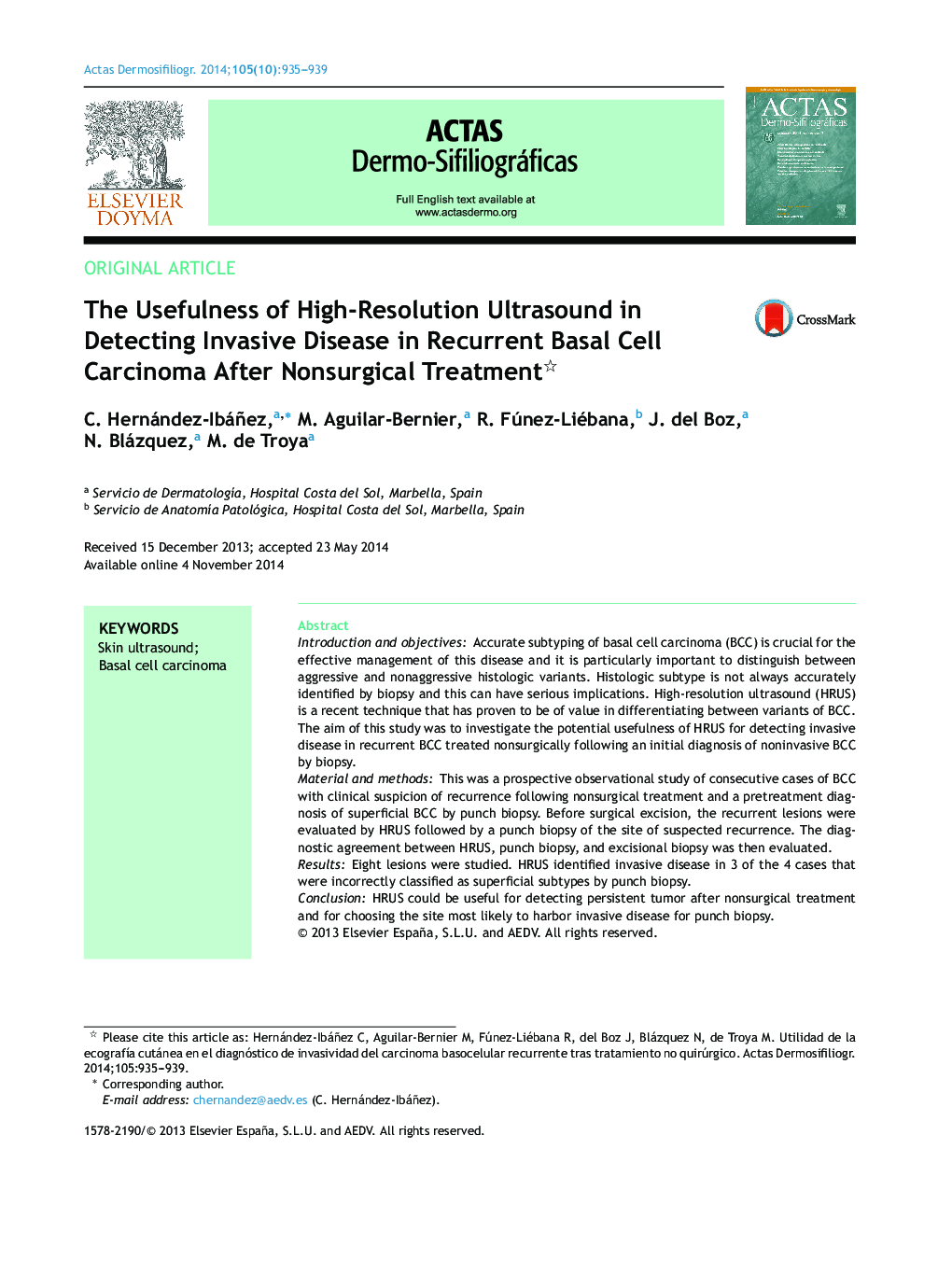| کد مقاله | کد نشریه | سال انتشار | مقاله انگلیسی | نسخه تمام متن |
|---|---|---|---|---|
| 3182289 | 1200647 | 2014 | 5 صفحه PDF | دانلود رایگان |
Introduction and objectivesAccurate subtyping of basal cell carcinoma (BCC) is crucial for the effective management of this disease and it is particularly important to distinguish between aggressive and nonaggressive histologic variants. Histologic subtype is not always accurately identified by biopsy and this can have serious implications. High-resolution ultrasound (HRUS) is a recent technique that has proven to be of value in differentiating between variants of BCC. The aim of this study was to investigate the potential usefulness of HRUS for detecting invasive disease in recurrent BCC treated nonsurgically following an initial diagnosis of noninvasive BCC by biopsy.Material and methodsThis was a prospective observational study of consecutive cases of BCC with clinical suspicion of recurrence following nonsurgical treatment and a pretreatment diagnosis of superficial BCC by punch biopsy. Before surgical excision, the recurrent lesions were evaluated by HRUS followed by a punch biopsy of the site of suspected recurrence. The diagnostic agreement between HRUS, punch biopsy, and excisional biopsy was then evaluated.ResultsEight lesions were studied. HRUS identified invasive disease in 3 of the 4 cases that were incorrectly classified as superficial subtypes by punch biopsy.ConclusionHRUS could be useful for detecting persistent tumor after nonsurgical treatment and for choosing the site most likely to harbor invasive disease for punch biopsy.
ResumenIntroducción y objetivosLa determinación del subtipo histológico de carcinoma basocelular (CBC) es crucial en el adecuado abordaje del mismo (sobre todo diferenciar variantes agresivas de no agresivas). En ocasiones la biopsia falla en la correcta catalogación del mismo con sus conocidas consecuencias. La ecografía cutánea de alta frecuencia (ECAF) es una técnica reciente que ha mostrado potencialidad en la distinción de variantes de CBC. El objetivo del estudio fue mostrar la posible utilidad de la ECAF en la identificación de la invasividad del CBC recurrente tras tratamientos no quirúrgicos diagnosticados mediante biopsia como no invasivos.Material y métodosEstudio observacional, prospectivo de casos consecutivos de CBC con sospecha clínica de recurrencia tras tratamiento no quirúrgico y que previamente a dicho tratamiento habían sido diagnosticados por biopsia-punch como variantes superficiales. Previamente a la extirpación quirúrgica de los mismos se realizó una ecografía de la lesión y posteriormente un punch de la zona sospechosa de persistencia. Finalmente se estudió la tasa de concordancia entre los resultados diagnósticos de cada una de las pruebas (ECAF, biopsia-punch y biopsia escisional).ResultadosSe incluyeron 8 casos. De entre los 4 casos en los que la biopsia-punch realizó una mala clasificación de invasividad (eran realmente subtipos invasivos pero la biopsia-punch determinó subtipos superficiales), la ECAF fue capaz de detectar dicha invasividad en 3 de ellos.ConclusiónLa ECAF podría ser de utilidad en la detección de persistencias tumorales de CBC tras tratamientos no quirúrgicos, permitiendo guiar la biopsia-punch en la detección del área más sospechosa de infiltración.
Journal: Actas Dermo-Sifiliográficas (English Edition) - Volume 105, Issue 10, December 2014, Pages 935–939
